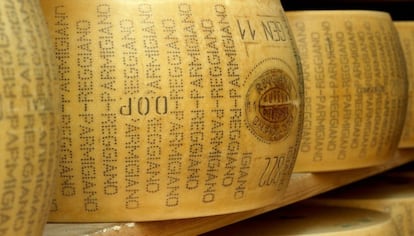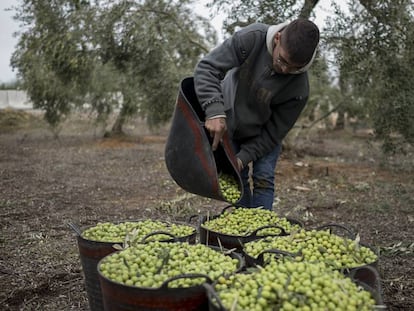Cheesemakers experiment with microchips to authenticate Parmigiano Reggiano
Manufacturers are exploring the use of microprocessors embedded in cheese wheels to track and identify them

The huge wheels of Parmigiano Reggiano cheese, weighing up to 90 pounds (40 kg), are perfect flavor enhancements for pasta dishes, soups and arugula salads. They are highly treasured in Italian gastronomy worldwide, but unfortunately, they are also frequently counterfeited. To safeguard their products, producers of these timeless delicacies have turned to technology. Cheesemakers are currently testing a new security system that involves embedding a microchip, smaller than a grain of salt, into the cheese rind. This microchip acts as an identification card, allowing the entire cheesemaking process to be tracked and also certify the authenticity of the final product.
Riccardo Deserti leads the Parmigiano Reggiano Consortium, an association that has been overseeing production and combating cheaper imitations of this cheese for more than a century. Because these imitations do not follow the demanding cheesemaking requirements to make the real thing, Deserti says the association has been experimenting for over a year with microchip identification. Starting in 2024, their objective is to equip nearly four million wheels with a microchip made by p-Chip, an American corporation. “We’re the first cheese to work with this technology. Once we complete our tests, other cheeses like Grana Padano or French and Spanish cheeses can also benefit from this system to ensure their authenticity,” said Deserti. The microprocessor is inserted into the rind and is completely harmless to consumers. “It can also be removed before grating the cheese,” he said.
According to Deserti, cheeses have had an authentication system since 2002 that consists of a casein plate made from milk proteins, integrated into the Parmigiano Reggiano rind. The plate contains a unique alphanumeric verification code that stores all the necessary information for tracking, similar to clothing labels. “Because the system is analog, there’s a risk of accidentally erasing the information just by touching or using the plate. Microchips guarantee that the information is always readable... It’s a big leap in quality,” said Deserti.
Parmigiano Reggiano is one of humankind’s oldest and most cherished cheeses. Even today, it is crafted using an age-old artisanal technique, unaltered by time, employing only the purest ingredients: milk, salt and rennet. Completely devoid of additives, this cheese was granted the coveted Protected Designation of Origin (PDO) from the European Union in 1996, which means that no other European cheese can use the name. Now it enjoys EU protection due to its exceptional qualities and close ties to its birthplace — the regions of Parma, Reggio Emilia, Modena, Mantua east of the Po River, and Bologna west of the Reno River. But this designation also requires strict adherence to the standards set out in the official regulation. Other European food products that have been granted PDO designations include French champagne, Portuguese port wine, Spanish Rioja wine, Spanish Jabugo ham and Greek kalamata olive oil.
Because of the stringent certification requirements, these delicacies often command higher prices, attracting imitators. Producers estimate that global sales of counterfeit cheese amount to around $1.73 billion (€1.6 billion) annually. This number is close to the sales of the authentic product, which reached a record $3.14 billion (€2.9 billion) last year. Roughly half of these sales are from exports, which is a 7% increase compared to 2021.
Coldiretti, the top farmer-rancher association in Italy, has observed a substantial increase in counterfeit food product sales over the past 30 years. Their research indicates that Parmigiano Reggiano is the second most frequently counterfeited Italian food product, just behind mozzarella cheese.

According to Coldiretti, Brazil produces a type of Parmesan cheese called Parmesao. In Russia, there is Russkiy Parmesan, and in Argentina, descendants of Italian immigrants produce Reggianito. “The rise of Italian-sounding brands has led to a concerning increase in counterfeit Italian food products, with over two-thirds of them being fake,” stated a recent Coldiretti report. In the United States alone, the production of imitation Italian cheeses reached an astonishing 5.7 billion pounds (2.6 billion kilos) in 2021, according to Coldiretti. The sale of counterfeit products has outpaced even beloved American cheeses like Cheddar, Colby and Monterrey Jack. Coldiretti found that a staggering 90% of the cheese sold as Parmigiano Reggiano, Grana Padano, mozzarella and gorgonzola in the United States is actually produced in states like Wisconsin, New York and California.
Last year, the Parmigiano Reggiano Consortium succeeded in blocking U.S. food giant Kraft Heinz from registering the trademark “Kraft Parmesan Cheese” in Ecuador, calling it a notable victory given that EU PDO status is not globally recognized outside Europe. Italian producers consider it a significant triumph as it emphasizes the crucial connection between the product, region and designation of origin. By digitizing the authentication process using microchips, Deserti said their aim is to transmit the product’s value globally and differentiate it from similar products in the market that don’t meet stringent production and origin requirements.
Parmesan cheese made outside the designated area of origin is considered counterfeit. To meet PDO requirements, the milk must be sourced from that area, made into cheese, aged for at least 12 months, and then packaged or grated. The Consortium says the milk from the area has unique qualities influenced by the fodder or grass consumed by the cows. No additives are permitted, such as laboratory-produced bacteria used to alter the naturally occurring bacteria in raw milk. ”Only a skilled cheesemaker can bring out the natural lactic bacteria during fermentation in a delicate process that produces the flavors and textures that make an exceptional cheese,” said the Consortium.
Parmigiano Reggiano originated during the Middle Ages, when monks sought to make a long-lasting cheese. The earliest known mention of this delicacy is in a 1254 notarized document from the Genoa State archives, referring to caseus parmensis. Perhaps the first reference to using Parmesan on food comes from Giovanni Boccaccio’s 1344 book, The Decameron, which describes Bengodi, an imaginary land of plenty where cooks used flourishes of “grated Parmigiano” to flavor their macaroni and ravioli dishes.
Sign up for our weekly newsletter to get more English-language news coverage from EL PAÍS USA Edition
Tu suscripción se está usando en otro dispositivo
¿Quieres añadir otro usuario a tu suscripción?
Si continúas leyendo en este dispositivo, no se podrá leer en el otro.
FlechaTu suscripción se está usando en otro dispositivo y solo puedes acceder a EL PAÍS desde un dispositivo a la vez.
Si quieres compartir tu cuenta, cambia tu suscripción a la modalidad Premium, así podrás añadir otro usuario. Cada uno accederá con su propia cuenta de email, lo que os permitirá personalizar vuestra experiencia en EL PAÍS.
¿Tienes una suscripción de empresa? Accede aquí para contratar más cuentas.
En el caso de no saber quién está usando tu cuenta, te recomendamos cambiar tu contraseña aquí.
Si decides continuar compartiendo tu cuenta, este mensaje se mostrará en tu dispositivo y en el de la otra persona que está usando tu cuenta de forma indefinida, afectando a tu experiencia de lectura. Puedes consultar aquí los términos y condiciones de la suscripción digital.
More information
Archived In
Últimas noticias
Most viewed
- Reinhard Genzel, Nobel laureate in physics: ‘One-minute videos will never give you the truth’
- Oona Chaplin: ‘I told James Cameron that I was living in a treehouse and starting a permaculture project with a friend’
- Pablo Escobar’s hippos: A serious environmental problem, 40 years on
- Why we lost the habit of sleeping in two segments and how that changed our sense of time
- Chevy Chase, the beloved comedian who was a monster off camera: ‘Not everyone hated him, just the people who’ve worked with him’











































